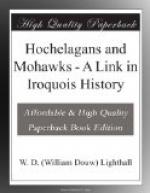[Illustration: SHALLOW GRAVE IN PREHISTORIC BURYING GROUND AT WESTMOUNT ON MOUNT ROYAL SHOWING ATTITUDE OF SEPULTURE.]
The likeness of the names Tekenouday and Ajoaste to that of the Huron town Tekenonkiaye, and the Andastean Andoaste, shows how close was the relationship. Nevertheless the Hochelagans were quite cut off from the Hurons, whose country as we have found, some of them point to and describe to Cartier as inhabited by evil men. As the Stadacona people, more distant, independently refer to them as good, no war could have been then proceeding with them.
In 1540 when Roberval came—and down to 1543—the conditions were still unchanged. What of the events between this date and the coming of Champlain in 1605? This period can be filled up to some extent.
About 1560 the Hurons came down, conquered the Hochelagans and their subject peoples and destroyed Hochelaga. I reach this date as follows: In 1646 (Relation of 1646, p. 34) Pere Lalemant reports that “under the Algonquin name” the French included “a diversity of small peoples,” one of which was named the Onontchataronons or “the tribe of Iroquet,” “whose ancestors formerly inhabited the island of Montreal,” and one of their old men “aged say eighty years” said “my mother told me that in her youth the Hurons drove us from this island.” (1646, p. 40.) This makes it clear that the inroad was Huron. Note that this man of eighty years does not mention having himself lived on the island; and also the addition “in her youth.” This fact brings us back to before 1566. But in 1642, another “old man” states that his “grandfathers” had lived there. Note that he does not say his parents nor himself. These two statements, I think, reasoning from the average ages of old men, carry us back to about 1550-60. Champlain, in 1622, notes a remark of two Iroquois that the war with the Hurons was then “more than fifty years” old. The Huron inroad could not likely have occurred for several years after 1542, for so serious an incursion would have taken some years to grow to such a point out of profound peace. 1550 would therefore appear a little early. The facts demonstrate incidentally a period of prosperity and dominance on the part of the Hurons themselves, for instead of a mere incursion, it exhibits, even if made by invitation of the Algonquins,




